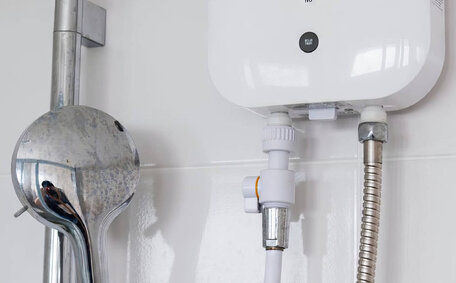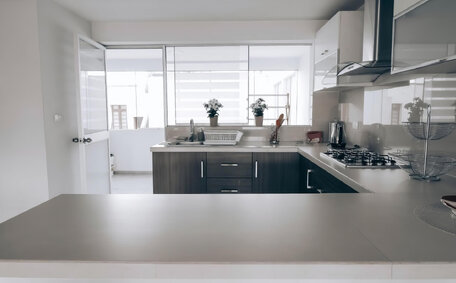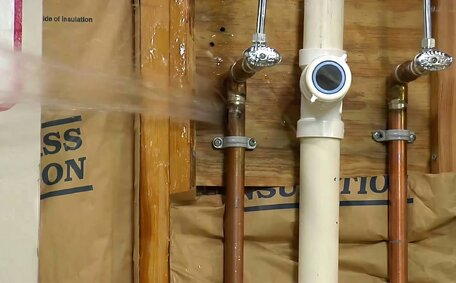Introduction: Why You Might Be Experiencing Cold Water
Experiencing cold water when you expect hot can be quite aggravating. At Bexley Plumbing, we recognise the disruption a malfunctioning hot water system can cause. As trusted plumbers serving Bexley, Sydney for over 10 years, we have the expertise to properly diagnose and resolve any hot water system problems you may be experiencing.
This article will guide you on what to check with a thorough checklist to troubleshoot and address common gas electric hot water issues. Our checklist addresses issues from blown fuses in electric heaters to ensuring optimal hot and cold water delivery. We include preventative maintenance tips to help you sidestep future cold water issues.
Follow these steps to expedite the restoration of your hot water system. We’ll provide essential tips on water heater care, including anode rod replacement, system flushing, pressure relief valve checks, and ongoing maintenance.
Our checklist encompasses electrical, thermostat, solar system, gas line issues, sediment buildup, and beyond.
Use our comprehensive guide to get your hot water flowing again. Should you require assistance, Bexley Plumbing is at your service to repair or replace your water heater.
Checking Your Water Heater Settings and Controls
Properly adjusting your water heater settings and controls is crucial for optimal performance and efficiency. Here are some key steps to check:
- Determine if your system utilises gas, electricity, a heat pump, or is tankless, as this can significantly influence operational controls.
- Check the thermostat is set to the recommended temperature of 49-60°C. Turning it down can save energy.
- Check that electric water heaters have the heating elements turned on. Gas water heaters with a storage tank need the pilot light lit to function correctly.
- Ensure your tankless heaters are getting adequate gas/power supply to keep hot water tap flowing. Consult manuals if unsure.
- Inspect digital controls like timers, vacation modes, and heat pump settings. Improper settings can waste energy.
- Assess mixing valves for proper blending of water to prevent scalding.
- Commercial heaters may have additional safety valves and controls. Verify proper settings.
- Regularly check thermostats for accuracy and recalibrate if necessary. Several factors like mineral buildup can affect temperature accuracy over time.
A brief inspection of water heater settings can enhance performance and may reduce energy costs. Don’t hesitate to ask a professional if you’re questioning why your hot water may be inconsistent or absent.
Inspecting the Pilot Light on a Gas Water Heater
Inspecting your gas water heater’s pilot light is essential for avoiding hot water disruptions. Here are some tips for properly inspecting the pilot light:
- Locate your heater’s pilot light assembly to ensure proper flame emission. It is usually near the bottom of the tank.
- Turn the gas control valve to the 'pilot’ position.
- Hold the reset button down as you ignite the pilot with a long match or lighter. Continue holding the reset for 30-60 seconds after lighting to allow the thermocouple to heat up.
- If the pilot extinguishes and fails to remain lit, repeat the previous steps. If it still won’t light, the thermocouple may need replacing.
- Inspect the colour of the pilot flame. It should burn steady and blue. A weak, yellow/orange flame indicates a need for service.
- Verify that the main burner ignites when you turn up the gas valve. If not, the pilot may be improperly aligned with the burner.
- Inspect the gas line leading to the water heater for any leaks using a spray bottle of soapy water. Bubbles indicate a gas leak that must be repaired.
- Check that the pilot assembly cover is properly in place when finished. This protects the pilot from drafts.
Routinely inspecting your gas water heater’s pilot light can help avoid running out hot and potentially dangerous gas leaks. If you have any difficulty relighting the pilot or suspect a problem, contact a professional plumber immediately.
Checking Valves and Gas Supply on Gas Water Heaters
Ensuring your gas water heater has proper gas supply and functioning valves is critical to its safe and efficient operation. Here are some key steps:
- Locate the main gas shutoff valve supplying the water heater and verify it is fully open.
- Make sure the unit’s gas control valve is open and correctly set, normally to the 'On’ position.
- Inspect the gas line and connections leading to the water heater for any signs of cracks, corrosion or leaks using a spray bottle of soapy water. Bubbles indicate a gas leak.
- Test the operation of the gas control valve by turning it to 'Pilot’ and observing the pilot light. Return it to 'On’ after testing.
- Ensure any manual gas line shutoff valves before the unit are fully open.
- Be alert for hissing sounds or a sulfuric odour that may indicate a gas leak.
- Replace the gas line flex connector if it shows any signs of wear, dry rot or corrosion.
- Contact a professional plumber immediately if you find any issues with gas valves, connections or supply lines.
Proper gas supply and intact valves are crucial safety factors in gas water heater operation. Do not hesitate to call a trusted plumber like Bexley Plumbing if you have any concerns about your gas water heater.
Testing Power Supply and Heating Elements on Electric Models
Testing the power supply and heating elements is important when troubleshooting electric water heater problems. Here are the steps to check these components:
- Initially, ensure that the circuit breaker for the water heater is activated for hot water flow. Turn it fully off and back on to reset it and address why your hot water might not be working.
- Check the power supply wires and connections leading into the water heater for any damage. Wires should be intact with no nicks or scorch marks.
- Remove the access cover and inspect the heating elements. Look for any cracks, corrosion, or burn marks. Elements should be fully submerged in water.
- Use a multimeter to check for continuity through the heating elements. A lack of continuity indicates faulty elements that need replacement.
- Verify the thermostats are working accurately and the control panel is functioning.
- Inspect the high limit safety switch and reset it if tripped. If it continues to trip, the switch likely needs replacing.
If circuit breakers and heating elements are operational, the problem likely exists in a different component. Contact a professional electrician or plumber for any complex electrical inspections or repairs needed on your electric water heater.
Examining Circulator Pumps in Hot Water Systems
Circulator pumps are essential for maintaining proper hot water flow in your property. If you experience intermittent loss of hot water, examining the circulator pump should be one of the first steps in troubleshooting. Here are some tips for inspecting circulator pumps:
- Check that the pump is getting power – confirm the supply switch is on and wires are connected.
- Inspect for leaks, odd noises or vibrations that could indicate a failing pump.
- Check the pump’s freedom of movement by rotating the motor shaft; difficulty in spinning indicates a problem.
- Make sure the pump housing is not excessively hot. Overheating can cause pump failure.
- Ensure adequate water pressure both into and out of the pump housing.
- Clear any trapped air in the system that could be impeding water flow.
- Consider replacing pumps past their prime, as circulators generally last between 5 to 10 years.
Replacing a circulator pump with a new high-efficiency model can improve hot water delivery while reducing energy costs. Contact a plumber if you need help addressing circulator pump problems or upgrades.
Clearing Sediment Buildup and Flushing Water Heaters
Over time, sediment buildup inside your water heater can reduce its efficiency and lifespan. Flushing the tank helps remove this sediment to improve performance. Here’s how to flush your water heater:
- Cut the power to the water heater and close the cold water supply valve.
- Attach a garden hose to the drain tank valve at the bottom of the tank and route it to a drain or outside.
- Open the drain valve and release pressure from the tank. Let water flow until it runs clear.
- Close the drain valve and reopen the cold water supply to refill the tank.
- Restart the water heater as normal once tank is full. Verify temperature settings.
Sediment buildup can increase energy consumption. With water heating responsible for 22% of energy use in Australian homes, keeping your system maintained is important.
Flushing annually can maximise efficiency. Contact a professional plumber if you have any difficulty with the process or need assistance servicing your water heater.
Adjusting Temperature Settings for Efficiency
- Review your owner’s manual for the recommended temperature settings, typically around 49°C.
- Begin by reducing your thermostat setting by about 5°C from its current level. Monitor your hot water supply for a week to make sure you still have adequate hot water.
- Think about fitting a thermostatic mixing valve to consistently provide water at safe temperatures below 49°C and prevent scalding. This allows you to increase the heater’s temperature while blending in cold water.
- Insulate exposed hot water pipes to minimise cooling before reaching faucets, especially recirculation lines.
- Set heaters with timers to only run during peak demand periods. Turn off during vacations or periods of low use.
- Maintain efficiency by regularly flushing sediment and replacing anode rods in your water heater.
Dropping the thermostat on your water heater by 5°C could cut energy use by 5-10%. Handle adjustments carefully and contact a professional plumber for assistance optimising your specific system.
Insulating Pipes and Tanks to Retain Heat
Insulating your water heater pipes and tanks is an easy way to improve efficiency and retain heat. Here are some tips:
- Use pipe insulation or pre-slit foam tubing to wrap hot water pipes. This prevents heat loss as water travels to fixtures.
- Choose a fibreglass or foam tank insulation jacket designed specifically for water heaters. Make sure it fits snugly.
- Insulate both hot and cold water pipes to reduce condensation buildup.
- Pay special attention to insulating recirculation lines which constantly cycle hot water.
- Make sure insulation is thick enough for the climate. Increase thickness to account for very cold winters.
- Seal all seams thoroughly with aluminium tape to prevent moisture intrusion.
- Inspect insulation routinely for any damage or gaps and repair as needed.
Properly insulating pipes and tanks can reduce standby heat losses by 25-45%. This improves energy efficiency while retaining enough heat to supply hot water consistently. Contact a professional plumber if you need help installing or replacing water heater insulation.
Installing Heat Traps to Prevent Heat Loss
Heat traps are simple, inexpensive devices that can help maximise the efficiency of your water heater system. By preventing convection heat loss, heat traps allow your water heater to operate optimally.
Heat traps are usually elbow fittings or baffles installed on the hot and cold water connections on your water heater tank. They work by blocking convection currents, forcing the hot water to stay within the tank rather than allowing it to rise out through the hot water pipe.
Without heat traps, the hottest water will rise to the top of the tank and escape through the hot water outlet as it is constantly replaced by cooler water entering through the cold inlet. This convection process results in considerable heat loss and energy waste.
Installing heat traps essentially traps the heat inside the tank, thereby reducing standby heat loss by up to 45%. This can lower energy consumption while delivering hot water more efficiently.
Heat traps are easy to install yourself. However, given the danger of working with plumbing lines and hot water tanks, it is advisable to have them installed by a licenced professional plumber. The plumber can ensure the heat traps are properly sized and positioned for maximum benefit.
By preventing convection heat loss from your hot water tank, heat traps are an effective way to optimise energy efficiency. Contact Bexley Plumbing to learn more about how heat traps can help reduce your energy costs and keep your hot water flowing optimally.
Heat traps are simple, inexpensive devices that can help maximise the efficiency of your water heater system.
Professional Maintenance and Repairs
While some basic troubleshooting steps ny issues that can lead to loss of hot water.
Annual maintenance should encompass:
- Inspecting heating elements, thermostats, gas valves and supply lines
- Checking for leaks, corrosion, sediment buildup
- Testing safety valves and controls
- Flushing and descaling the tank
- Replacing worn parts like circulator pumps
Professional repairs should be done anytime you encounter major problems getting hot water. Our licenced plumbers have the expertise to troubleshoot and fix any hot water system issue. We can do everything from replacing faulty heating elements to draining clogged tanks.
Don’t take chances on DIY repairs to complex water heating systems.
Annual Water Heater Inspections
Having your water heater inspected annually by a licenced plumber is one of the best ways to extend its lifespan and prevent unexpected loss of hot water. During routine maintenance visits, plumbers check for issues that can lead to inefficiency, corrosion damage, or even catastrophic tank failures if left unaddressed.
A qualified technician will thoroughly examine components like the heating elements, thermostat, valves, anode rod, and tanks for leaks or corrosion. They can flush sediment, descale buildup, and verify safety controls are working properly. Small part replacements like pumps or heating elements can be done to keep the system operating optimally.
At Bexley Plumbing, our preventative maintenance plans include an annual water heater inspection to identify and rectify any problems before they cause disruptive breakdowns. Investing in routine professional inspections gives you peace of mind knowing your hot water system is being properly cared for.
Don’t wait for an emergency to get your water heater checked. Schedule annual maintenance with our experts so you can enjoy consistent hot water for years to come. Contact Bexley Plumbing at 1300 349 338 to arrange professional inspections and repairs.
Conclusion: Keeping Your Hot Water Reliable
By following the troubleshooting checklist provided, you can get your hot water flowing again and take steps to prevent future problems.
The key points covered include inspecting heating elements, gas valves and supply lines, checking thermostat settings, clearing sediment buildup, replacing worn parts, and flushing tanks annually. With routine maintenance from a trusted plumber like Bexley Plumbing, your hot water system will operate smoothly for years to come.
Don’t tolerate the frustration of unreliable hot water any longer. Our experienced technicians have the expertise to diagnose and repair any hot water system issue - whether it’s a leaking electric heater or clogged gas tank. We handle installations, replacements, and maintenance.
For reliable plumbing services, reach out to Bexley Plumbing at 1300 349 338. Keeping your hot water system well-maintained gives you peace of mind and ensures your home always has a steady supply of hot water right when you need it.






